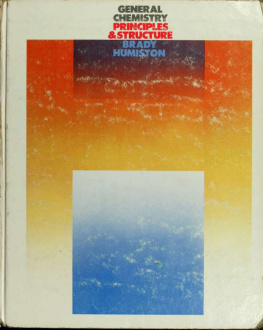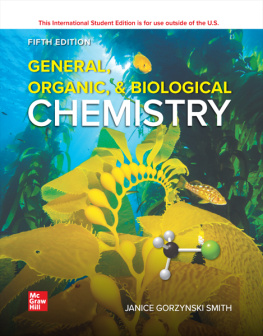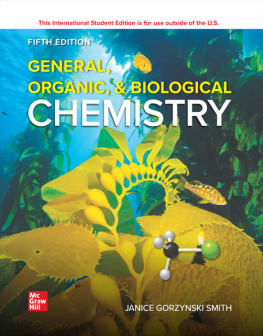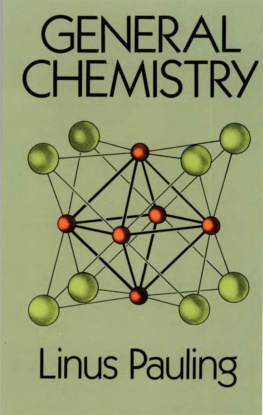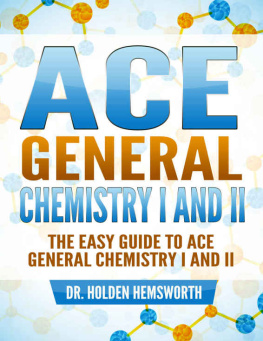Brady James E. - General chemistry : principles and structure
Here you can read online Brady James E. - General chemistry : principles and structure full text of the book (entire story) in english for free. Download pdf and epub, get meaning, cover and reviews about this ebook. City: New York, year: 1975, publisher: Wiley, genre: Children. Description of the work, (preface) as well as reviews are available. Best literature library LitArk.com created for fans of good reading and offers a wide selection of genres:
Romance novel
Science fiction
Adventure
Detective
Science
History
Home and family
Prose
Art
Politics
Computer
Non-fiction
Religion
Business
Children
Humor
Choose a favorite category and find really read worthwhile books. Enjoy immersion in the world of imagination, feel the emotions of the characters or learn something new for yourself, make an fascinating discovery.
- Book:General chemistry : principles and structure
- Author:
- Publisher:Wiley
- Genre:
- Year:1975
- City:New York
- Rating:4 / 5
- Favourites:Add to favourites
- Your mark:
- 80
- 1
- 2
- 3
- 4
- 5
General chemistry : principles and structure: summary, description and annotation
We offer to read an annotation, description, summary or preface (depends on what the author of the book "General chemistry : principles and structure" wrote himself). If you haven't found the necessary information about the book — write in the comments, we will try to find it.
General chemistry : principles and structure — read online for free the complete book (whole text) full work
Below is the text of the book, divided by pages. System saving the place of the last page read, allows you to conveniently read the book "General chemistry : principles and structure" online for free, without having to search again every time where you left off. Put a bookmark, and you can go to the page where you finished reading at any time.
Font size:
Interval:
Bookmark:

This book made available by the Internet Archive.





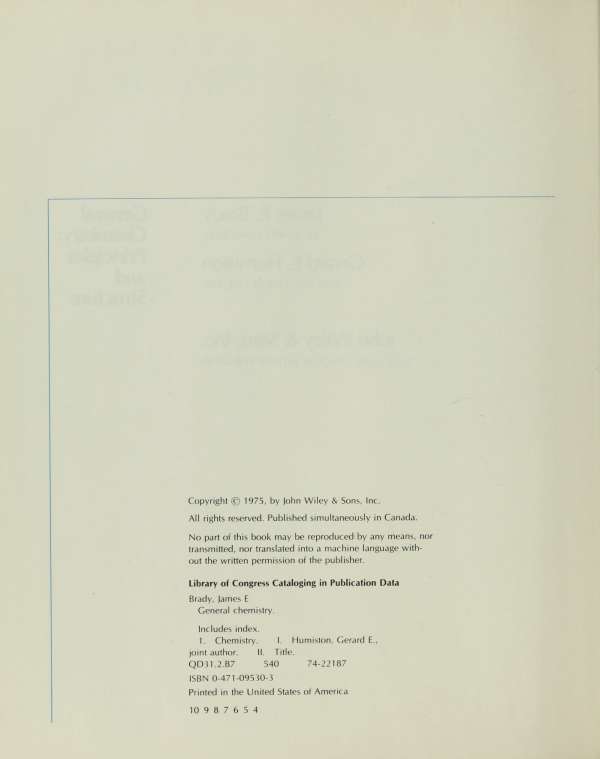
Preface
Why do many students find chemistry difficult? There is no simple answer, but it is probably because of the difficulty of conceptual communication between the instructor, the textbook, and the student. Our goal is to provide clear, complete, and understandable explanations and illustrations of the principles and concepts that will help the student to succeed in a general chemistry course.
In simple language we develop concepts and provide solutions to many example problems. We have assumed no prior learning in chemistry (even though the student may have had one year of high school chemistry), and we have carefully defined each new term before using it in the development of concepts. New terms are in boldface type and are indexed. Important definitions are italicized. Comprehensive problem sets are included at the end of each chapter, and the answers to the odd-numbered problems are given in Appendix E.
In terms of mathematical background, we have assumed only an ability to handle relatively simple algebra and an exposure to logarithms. A review of mathematical concepts is included in Appendix C. We have tried not to frighten the student with endless equations but, instead, to impress on him the importance of quantitative ideas in chemistry and the other sciences. Since most students of general chemistry have not been exposed to calculus, we avoid its use entirely.
Graphic illustrations are used liberally and, in this area, we feel that we have overcome a major deficiency in other textbooks, which rely on two-dimensional illustrations for the communication of the three-dimensional concepts. Although these illustrations are often well drawn and the objects that they depict are recognizable by chemists, students are not chemists. At the end of a general chemistry course, most students have only a vague appreciation for the three-dimensional aspects of chemistry. Furthermore, some two-dimensional representations are difficult to understand, even by chemists. (Coqsider, for instance, the closest packing of spheres.) If chemists cannot understand them, consider the poor freshman!
The solution to these difficulties is the use of stereoscopic illustrations, and we have included them liberally wherever it seemed pedagogically desirable. Our students' reactions to these illustrations have been favorable. They find them very useful instructional devices. A stereo viewer is included with the text.
We have retained many of the familiar metric system units, particularly the calorie (and kcal) for energy and the atmosphere for pressure. The complete changeover to SI units is several years away, and most practicing chemists and biologists still think and talk in metric units.
The sequence of topics follows a logical rather than purely historical development of concepts. The book begins with the development of the quantitative relationships involving atomic weights, formulas, and chemical equations to facilitate the early introduction of quantitative experiments in the laboratory.
The material on stoichiometry is followed by a discussion (in Chapter 3) of the structure of the atom and the periodic table. We have taken a historical approach, since the evolution of these concepts gives a historical perspective to our currently accepted notions about atomic structure.
The treatment of chemical bonding is divided into two chapters. Chapter
4 deals with the "classical" description of the chemical bond. The ideas developed will carry the student through about two thirds of the book. The modern theories of bonding and molecular structure are discussed in Chapter 16 so that they can be applied to the discussion of descriptive chemistry in the chapters that follow. Bonding theory has been introduced at this late stage for two reasons: (1) the more sophisticated theories are presented after the student has had an opportunity to mature somewhat in his or her understanding of chemistry; and (2) the student will not have forgotten the salient features of these theories by the time they are applied to descriptive chemistry. We believe that when the complexities of bonding are discussed in the first semester they will have to be reviewed extensively before they can be used in the second semester.
Our treatment of solutions is also divided between two chapters. Chapter
5 focuses on solutions (particularly aqueous solutions) as a medium for carrying out chemical reactions. Chapter 9, which follows a discussion of liquids (Chapter 8), deals with the physical properties of solutions as they are affected by the interactions between solute and solvent.
Chapter 5 introduces many important concepts that are developed in greater detail in later chapters (for example, chemical equilibrium and acid-base reactions). The stoichiometry of solutions, the concepts of ionic reactions, and acid-base and redox titrations are also discussed in Chapter 5. This chapter, at a relatively early stage, prepares students for a variety of quantitative and qualitative laboratory experiments that deal with reactions in solution. Furthermore, it reflects our attitude toward descriptive chemistry: students must know in detail certain aspects of the subject. This viewpoint is expressed in Chapter 5. We also feel that there are aspects of descriptive chemistry that a student should know about. We pursue the second approach in Chapters 17 to 19, where trends and similarities in properties (reactivity and structure) are stressed.
Students who have had a high-school chemistry course may be familiar with a good deal of the material in Chapter 5, and the instructor may assign portions of it for review. We think, however, that every student who has had a course in general chemistry should know this material thoroughly.
Thermodynamics (Chapter 10) and kinetics (Chapter 11) are included sequentially to relate the importance of these two factors in determining the outcome of a chemical reaction. The interplay between thermodynamics and kinetics is discussed later in connection with descriptive chemistry.
In Chapter 12, on equilibrium, the equilibrium law is discussed first as an experimental phenomenon, and then it is analyzed in terms of kinetics and thermodynamics. There follows a chapter on acids and bases, and the discussion of equilibrium is concluded with a chapter on ionic equilibrium.
Electrochemistry is considered in Chapter 15, which includes practical applications to electroplating, energy production, and the electrochemical measurement of concentrations.
As previously mentioned, the intention of the descriptive chemistry chapters (Chapters 17 to 19) is to display trends and similarities in the structure and reactivity of the elements and their compounds. These chapters are intended to illustrate points under discussion, and they should not be memorized by the student. Their dominant theme is structure, and the stereoscopic illustrations, particularly, fulfill an important role.
Font size:
Interval:
Bookmark:
Similar books «General chemistry : principles and structure»
Look at similar books to General chemistry : principles and structure. We have selected literature similar in name and meaning in the hope of providing readers with more options to find new, interesting, not yet read works.
Discussion, reviews of the book General chemistry : principles and structure and just readers' own opinions. Leave your comments, write what you think about the work, its meaning or the main characters. Specify what exactly you liked and what you didn't like, and why you think so.

